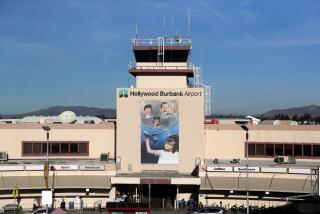Detroit Metro is rated the country’s best large airport
- Share via
Detroit has lost half its population since 1970. Unemployment remains stubbornly high and many of Motor City’s archetypal buildings are now derelicts, the ghosts of a more prosperous era.
Its airport is another story.
Not only did business pick up last year at Detroit Metro, it was rated the best large airport in the country in a nationwide review. It edged out Denver International and Minneapolis St. Paul International, which tied for second place in the 2010 North America Airport Satisfaction Survey by J. D. Power and Associates.
The results were welcome news for a Midwestern transportation hub that — until a rebuilding boom started a decade ago — had consistently ranked among the worst airports in the United States.
“We used to joke that Detroit was one step below Calcutta,” said Scott Wintner, an airport spokesman. “It was a place to avoid. We had cramped terminals and we could only move one plane at a time in the alleys. No other planes could back out.”
Basically, Detroit Metropolitan Wayne County International Airport, which serves Michigan, the Toledo, Ohio, area and southern Canada, has transformed itself into an aviation showplace.
“It’s a credit to Lester Robinson, the director there for many years,” said John L. Martin, who runs San Francisco International Airport. “Who would have thought that anybody could have built Detroit into a great airport?”
Detroit Metro officials said that Robinson, who served as airport director from 2000 to 2010, effectively executed the vision of then Wayne County chief executive Edward H. McNamara.
Wintner said an important factor in the modernization effort was a partnership between the airport and the airlines, which were allowed to plan the new facilities.
Obsolete terminals built in the 1960s and ‘70s were replaced with modern ones filled with dining opportunities, retail shops and displays that reflect the region’s culture. There is even WiFi and a prayer room.
Among the improvements is the McNamara Terminal, which opened in 2002. A mile long , it is the world’s second-longest terminal, a design that makes it easier for jetliners to reach and leave the gates. The airport’s separate North Terminal opened in late 2008.
Trams and moving sidewalks help passengers navigate the long complex, which includes a Westin Hotel, a conference center, a Henry Ford Museum store and a Hockeytown Cafe filled with Redwings and Tigers memorabilia.
“Detroit has a gorgeous terminal,” said Alan Rothenberg, the former chairman of the Los Angeles Board of Airport Commissioners, which sets policy for LAX. “You get off the plane and you know you are in Detroit. Los Angeles has many iconic things. But go into one of our terminals and you could be in any terminal.”
Last year, Detroit Metro, which is a major hub for Delta Airlines, handled 32.4 million passengers, about 4 million fewer than its peak in 2005. As the nation began recovering from the recession, the number of passengers increased by about a million from 2009 to 2010.
Although urban Detroit has been hollowed out by deindustrialization, the airport has thrived because of the modernization effort and strong population growth in surrounding suburbs.
In the J. D. Power survey of 12,100 travelers, passengers said Detroit Metro reflected many of the characteristics that the ideal airport should have. They handed out good to excellent marks for accessibility, check-in and baggage check, baggage claim, the security screening process, the quality of terminal facilities, dining and retail shops.
San Francisco International Airport ranked 13th out of the 20 airports in the large category. Los Angeles International finished next to last.
Stuart Greif, vice president of global travel and hospitality at J.D. Power, said many airports can improve the passenger experience by simply focusing on key elements—the clarity of airport signage, quick and accurate delivery of baggage, and shortening the wait at security checkpoints.
He noted that passengers who are pleased with their experience spend 45% more in airport shops and restaurants than those who aren’t.
“The basics still matter,” Greif said, but “the bar will be constantly raised and today’s innovation will be tomorrow’s expectation. Those that lag behind will get punished the worst.”
More to Read
Sign up for Essential California
The most important California stories and recommendations in your inbox every morning.
You may occasionally receive promotional content from the Los Angeles Times.














